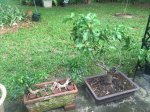miker
Chumono
In 2006, I decided I had to have a live oak bonsai originating from a beautiful ancient tree right near my parent's former house. This tree must be 300 years old, the trunk is gargantuan.
I grew my tree from an acorn sprouted in 2006 and grown in the ground, with a wooden slab underneath the roots. For the first 6 years, this tree was grown in the ground and trimmed back once per year in February, just before growth resumed. In February 2012, I dug the tree and planted it in the training pot seen in the photo. Since 2012, I have still only pruned it once per year, but with a more careful eye to developing primary and secondary branching.
The trunk is getting there in terms of thickness (about a 2.5-3" nebari at the moment), but I am going to keep it in the training pot for 2-3 more years to allow it to thicken a bit more. As is probably obvious, I want the tree to be a natural style which mimics the natural form of Quercus virginiana.
Note, the nebari does flare at the base, but this is not currently visible due to surface detritus. I will clean this up and post a photo in the near future.
What does everybody think? Suggestions?
I grew my tree from an acorn sprouted in 2006 and grown in the ground, with a wooden slab underneath the roots. For the first 6 years, this tree was grown in the ground and trimmed back once per year in February, just before growth resumed. In February 2012, I dug the tree and planted it in the training pot seen in the photo. Since 2012, I have still only pruned it once per year, but with a more careful eye to developing primary and secondary branching.
The trunk is getting there in terms of thickness (about a 2.5-3" nebari at the moment), but I am going to keep it in the training pot for 2-3 more years to allow it to thicken a bit more. As is probably obvious, I want the tree to be a natural style which mimics the natural form of Quercus virginiana.
Note, the nebari does flare at the base, but this is not currently visible due to surface detritus. I will clean this up and post a photo in the near future.
What does everybody think? Suggestions?


